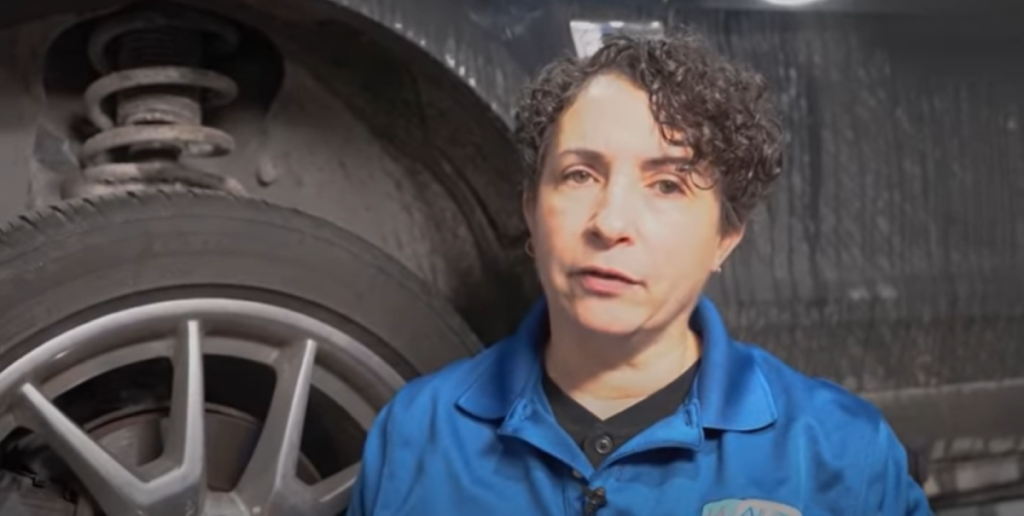You may ask yourself “Why does my car feel like it’s swaying when turning?” after feeling drifting or pulling when turning or taking a corner. If this happens, you’ll want to check the front end like the strut and sway bar links to make sure your car or truck is safe to drive. If the strut is not working properly and not holding its side of the vehicle up, you may feel like your car is drifting more than it needs to, and it may feel dangerous. Our mechanic Sue reviews how to diagnose this problem in this video.
Why Does My Car Feel Like It’s Swaying When Turning?

If you feel your car is swaying or pulling when turning, there could be a problem with:
- Struts
- Strut Mounts
- Tie Rods
- Wheel Bearing
How to Diagnose a Car That Is Swaying, Pulling, and Drifting When Turning
Steps to take to diagnose a car swaying, pulling, or drifting when turning
- Check the Front Strut Coil Spring
The coil on the front struts can crack and break, and sand and road salt can fall on the strut and break down the coil. Start at the top and feel the spring for movement. You should not have excessive movement. Feel down to the bottom of the coil. You may need a flashlight and mirror to see the coil spring in the seat at the bottom of the strut.
Check the distance of open gaps between the coil spring as it wraps around the strut. There should not be a wider space at one section more than another, which can indicate the coil is tighter from a missing piece, for example.
Jack the vehicle up and see if the coil on the other side looks or feels to have gaps of equal height as the opposite side. The spring should be tighter on the strut if it’s not damaged, with smaller gaps in the spring. A 1/8″ to 1/4″ difference between the two strut springs indicates a problem.
Even if the other strut is still in working condition but is worn, replacing the struts in pairs provides equal strength.
- Check the Tie Rod Ends and Wheel Bearing
Raise and secure the front end. If you need to, you may need a jack to support the lower control arm. With the front end raised, grab the wheel from the 3 and 6 o’clock position. Press from side-to-side, feel for excessive play, and listen for noise. You may hear squeaking, like from a bad strut mount, or feel looseness like from a bad tie rod end.
Grab the wheel from the 12 and 6 o’clock position and press it in and out, feeling for looseness or play, which can indicate a problem with the wheel bearing.
- Check the Inner Tie Rod End
One method to check the inner tie rod end that doesn’t involve moving the tire with the vehicle raised includes a trash bag. Place a trash bag underneath the tire on level ground. Have an assistant look at the steering wheel. Turn the wheel side-to-side from the 3 and 9 o’clock position. If the inner tie rod end is bad, you’ll feel play and the steering wheel will not be moving. If it’s in good condition, the steering wheel will be moving back and forth from a straight and tight connection up to the steering shaft.

- Check the Strut Mount
If the strut is squeaky and there are no problems with the tie rods or the coil spring, there could be an issue with the strut cap. A broken coil spring may be the cause of a squeaky strut cap, and you may be able to hear a bad strut mount when checking for other parts, like a tie rod end, if it has no pressure against the strut and is loose enough to make noise from air gaps, but the cap can also wear on its own. You can also diagnose a mount cap at home with a floor jack.
If the strut mount is bad, you’ll be able to hear it when turning with the vehicle stopped or moving. It will make a creaking or growling sound that can be heard with the vehicle parked.
Raise the lower control arm to bring the strut up to simulate where it would be if the vehicle was on the road, and then lower the jack completely. Look for up and down motion at the strut cap shaft in the center, which should have no movement. If the rubber is broken internally or if the strut mount has bearings and those bearing pieces are worn, there will be an air gap and then the strut mount will move. The strut mount should not move. Usually the rubber breaks and then the plastic separates, but the bearings can also break down over time from wear and corrosion.
Look at the distance from the top of the center shaft to the nut on both sides. The distance should be equal. If the distance on one strut is higher than the other, the sides are not equally tight and you’ll find movement in the looser strut. This problem can make a thumping noise and eventually destroy the strut assembly.
If the strut mount is damaged, replace the entire assembly. We recommend replacing the struts on both sides.
Learn how to fix more than your car drifting or swaying when turning
Our how-to videos have step-by-step instructions, tips, and advice from experienced mechanics. Find a video specific to your car or learn general knowledge and diagnostic tips about parts in your car.
Shop parts
Read more on how to check front end suspension and other parts
- Tire Size Guide—What the Letters and Numbers Mean
- What Is a Tail Light? Tail Lights 101
- How to Tell Which Wheel Bearing Is Bad While Driving
- Clunking Noise in the Front End?


